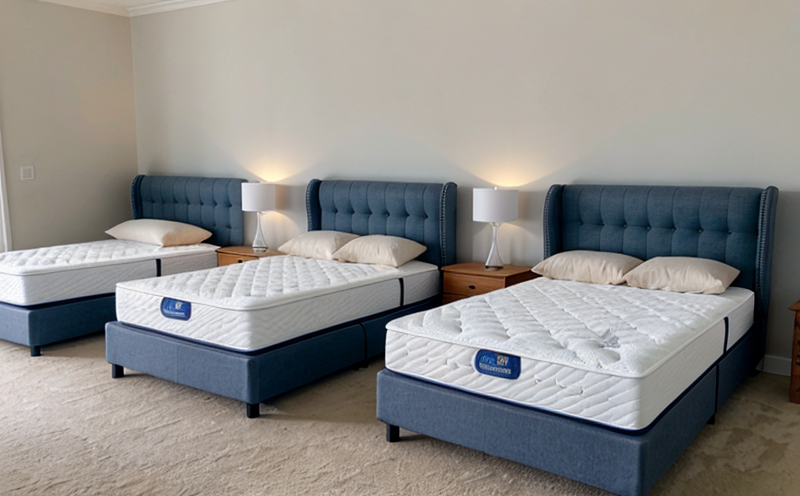UNE EN 1957 Functional Performance of Mattresses Testing
The UNE EN 1957 standard is a pivotal document in the furniture industry, specifically for testing the functional performance of mattresses. This standard ensures that mattresses meet specific requirements regarding comfort, durability, and safety under various conditions. Compliance with this standard is crucial for manufacturers to ensure their products are safe and reliable before entering the market.
The test covers a range of parameters including static load distribution, dynamic stability, pressure points, and overall comfort. The mattress is subjected to different loads that simulate real-world scenarios such as sitting or lying down. This testing method aims to identify any potential issues early in the product development cycle, thereby reducing costly rework later on.
Manufacturers typically follow several steps during this testing process: selecting appropriate test specimens (mattresses), preparing them according to specified guidelines, applying loads with specific increments and durations, recording data points like pressure distribution maps, and analyzing the results against UNE EN 1957 requirements. The goal is not just compliance but also continuous improvement towards better products.
UNE EN 1957 emphasizes the importance of consumer safety by addressing issues such as sleep disorders which could be exacerbated by poor-quality mattresses. By adhering to this standard, manufacturers can provide consumers with safer and more comfortable sleeping solutions. Furthermore, it helps in setting industry benchmarks ensuring that all mattresses meet minimum functional performance standards.
The benefits extend beyond mere compliance; they enhance brand reputation among discerning customers who value quality assurance above price alone. This commitment to high standards also attracts greater consumer trust, potentially leading to increased sales and customer loyalty.
Eurolab Advantages
At Eurolab, our expertise in furniture testing ensures that we offer unparalleled services when it comes to UNE EN 1957 Functional Performance of Mattresses Testing. Our team comprises highly qualified professionals with extensive experience in this field.
We provide a comprehensive service package starting from initial consultation through to final reporting and certification. This approach allows us to tailor our solutions specifically for each client’s unique needs, whether they are small startups or large corporations.
Our state-of-the-art facilities equipped with advanced instrumentation enable precise measurement and analysis throughout the testing process. We employ cutting-edge techniques such as pressure mapping systems that offer detailed insights into how a mattress behaves under various conditions. These tools allow us to capture data accurately, providing reliable evidence needed for successful certification.
Our commitment goes beyond just technical excellence; we also prioritize customer satisfaction by offering transparent communication channels and timely responses to queries or concerns. We understand that every project has its own timeline requirements, so flexibility in scheduling is always a priority.
In summary, choosing Eurolab for your UNE EN 1957 Functional Performance of Mattresses Testing needs means partnering with experienced professionals who bring together technical expertise, modern facilities, and personalized service. Together, we can ensure that your products meet all relevant standards while delivering exceptional value to end-users.
Environmental and Sustainability Contributions
Incorporating sustainable practices into mattress manufacturing is increasingly important given today’s environmental concerns. UNE EN 1957 Functional Performance of Mattresses Testing plays a crucial role here by ensuring that mattresses not only meet quality standards but also contribute positively to the environment.
One way this contributes is through improved resource efficiency during production. By identifying potential weaknesses early on, manufacturers can reduce waste and minimize energy consumption throughout the manufacturing process. This leads to lower carbon footprints associated with producing these products.
In addition, UNE EN 1957 helps promote the use of eco-friendly materials which are more durable and require less frequent replacement. Longer-lasting mattresses mean reduced demand for new resources, thus promoting circular economy principles.
Moreover, compliance with this standard encourages manufacturers to think about end-of-life disposal options. For instance, they might design products that can be easily recycled or repurposed, reducing landfill waste and environmental impact further down the line.
The commitment to sustainability does not end at manufacturing; it extends throughout the product lifecycle including proper usage instructions provided by rigorous functional performance testing according to UNE EN 1957. Proper use ensures longer lifespan of mattresses which is beneficial for both consumers and planet alike.
By embracing these practices, manufacturers contribute significantly towards creating a more sustainable future while maintaining high-quality standards expected by consumers worldwide.
Use Cases and Application Examples
The application of UNE EN 1957 Functional Performance of Mattresses Testing is vast and varied across different sectors. Here are some specific use cases:
- Hospital Beds: Ensuring that hospital beds meet the stringent requirements for patient safety, comfort, and support.
- Sports Equipment: Testing mattresses used in sports equipment to ensure they provide adequate cushioning without compromising on firmness or stability.
- Elderly Care: Designing mattresses specifically for elderly individuals who need additional support while maintaining flexibility and ease of movement.
- Travel Industry: Developing lightweight yet functional travel mattresses that offer comfort during long journeys.
The testing process involves multiple stages where different types of materials are used to simulate real-world scenarios. For example, in the case of hospital beds, the mattress might be subjected to higher loads than a regular home mattress due to the weight and size of patients. This ensures that even under extreme conditions, the product remains safe and functional.
Another important aspect is the durability testing which assesses how long the mattress can maintain its original properties despite continuous use over extended periods. This helps manufacturers understand the lifespan of their products better and make informed decisions regarding material selection and design improvements.
The results from these tests play a critical role in decision-making processes within companies involved in mattress production. They help identify areas for improvement, ensuring that every aspect of the product meets or exceeds expectations set by UNE EN 1957 standards. This way, manufacturers can create products that are not only safe but also environmentally friendly and user-friendly.





